Majha
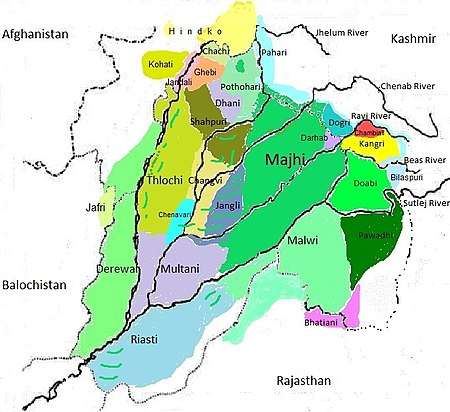
The Majha (Punjabi: ਮਾਝਾ (Gurmukhi), ماجھا (Shahmukhi); Mājhā) region is recognized as the region that is located at the center of the historical Punjab region,[1] that is northward from the right banks[note 1] of river Beas, and extends up to river Jhelum at its northmost.[2] People of the Majha region are given the demonym "Mājhi". The Majhi dialect of Punjabi language is the main language of this region, which is also the standard dialect of the Punjabi language.[3] The most populous city in the area is Lahore on the Pakistani side of the border.
During the partition of India in 1947, the Majha region of Punjab got split into India and Pakistan when the Indian Punjab and Pakistani Punjab were formed. The Majha region of Indian State of Punjab covers the area between Beas and Ravi rivers, including the area on the north of Sutlej, after the confluence of Beas and Sutlej at Harike in Tarn Taran district, extending up to the Ravi river, which is all part of the Majha region in India.[4] This region contains four districts of Indian state of Punjab - Amritsar, Tarn Taran, Gurdaspur, and Pathankot.
The people of the Majha region have been historically known to be fierce and stubborn fighters and in lieu of this, the Majha region is called the "Sword Arm of the Country", due to it contributing disproportionately to the Officer as well as Orderly ranks of the Army. [5] The Sikh Empire was founded in the Majha region which is also referred to as "the cradle of the brave Sikhs." [6]
History
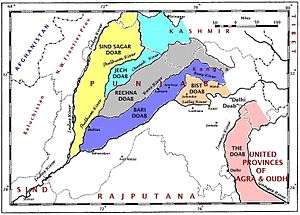
The word "Mājhā" (ਮਾਝਾ) means the "central" or the "heartland". The Majha region is geographically located in the middle (or central part) of the historic Punjab region, hence giving it the name Majha.[7] It includes a considerable portion of the Bari Doab (the region between the rivers Beas and Ravi) and the Rechna Doab (the region between the rivers Ravi and Chenab), and a smaller portion of the Jech Doab region (the region between the rivers Jhelum and Chenab).[8]
The Majha region of historical Punjab region spans northward from the right banks[note 1] of river Beas, and extends up to river Jhelum at its northmost,[2] making it the largest regions of historic Punjab.
The partition split the Punjab Province (British India) into the two states of West Punjab (Punjab, Pakistan) and East Punjab. However, the historic Majha region is arguably still the same as before since the partition does not change the previous history of Punjab, therefore does not change the geography of the Majha region of the historic Punjab region.
The Indian state of Punjab has continued to recognize the Majha region through maintaining the districts that have always belonged to the renowned historic Majha region. However, Majha being the only region that the Pakistani province of Punjab had, it has made Lahore as its provincial capital consisting of 10 sub-divisions such as Bahawalpur, Dera Ghazi Khan, Faisalabad, Gujranwala, Lahore, Multan, Rawalpindi,[9] Sahiwal and Sargodha.
Districts of Majha
The following districts are classified as Majha:[2]
| Majha districts of Panjab, India in 2016 | Majha districts of Punjab, Pakistan |
|---|---|
| Amritsar | Gujranwala, Narowal, Sheikhupura |
| Tarn Taran | Lahore, Kasur, Faisalabad, Hafizabad, Mandi Bahauddin |
| Gurdaspur | Nankana Sahib, Pakpattan |
| Pathankot | Sialkot, Sahiwal, Gujrat, |
Tourist attractions
- The Golden Temple Harmandir Sahib, Amritsar
- Jallianwala Bagh, Amritsar
- Harike Pattan bird sanctuary, Tarn Taran
- Wagah border ceremony, Wagah border between Amritsar India and Lahore Pakistan.
- Ranjit Sagar Dam, Shahpur Kandi, Pathankot
- Durgiana Temple, Amritsar
- Gobindgarh Fort, Amritsar
- Shahpur Kandi Fort, Pathankot
- Nurpur Fort, Pathankot
- Coronation platform of Akbar, Kalanaur, Gurdaspur
- Shamsher Khan's tomb, Batala
- Wagah border ceremony at Wagah border, Amritsar-Lahore
- Pul Kanjri, Amritsar
- Badshahi Mosque, Lahore
- Lahore Fort (Shahi Qila), Lahore
- Bagh-e-Jinnah, Lahore
- Lahore Museum, Lahore
- Shalimar Gardens, Lahore
- Tomb of Jahangir, Lahore
Notable residents
- Baba Deep Singh Ji (1682–1757), the most renowned and hallowed martyrs in Sikhism.
Nawab Jassa Singh Ahluwalia Sikh General and the head of Dal Khalsa
- Maharaja Ranjit Singh of Panjab (1780–1839), the founder of the Sikh Empire.
- Hari Singh Nalwa (1791–1837), renowned warrior and Commander-in-chief of the Sikh Khalsa Army, the army of the Sikh Empire.
- Bhai Bidhi Chand Chhina (1640), the greatest Sikh warrior and religious preacher at the time of Guru Hargobind Sahib Ji.
- Akali Phula Singh Ji (1761 – 1823), highly respected Akali Nihang Sikh general and Jathedar of the Khalsa Panth.
- Baba Budha Ji, venerated primal figure of early Sikhism.
- Sham Singh Atariwala (1790 - 1846), the general of the Sikh Empire.
- Baba Baghel Singh, who occupied Delhi
- Baba Gurdit Singh, SS Komagata Maru
- Bhai Maha Singh, Sikh Martyr
- Dara Singh wrestler
- Gurdial Singh Dhillon, ex-speaker of Lok Sabha, India
- Jagbir Singh Chhina, freedom fighter.
- Gurpreet Singh (shooter), winner of two medals in Commonwealth Games, Delhi
- M. S. Gill, former chief Election Commissioner of India and former sports Minister of India
- Mai Bhago, Sikh martyr
- Pratap Singh Kairon, ex-Chief Minister of Punjab
- Surender Mohan Pathak, Novelist
- Teja Singh Samundri, founder of SGPC
- Baba Sohan Singh Bhakna, Founder and President of Gadar party
- Sardar Baj Singh, Sikh general, governor and martyr.[10]
- Bhai Bhag Singh Bhikhiwind, leader of the Ghadar Party (1914)[11]
- Sardar Chhajja Singh Dhillon, a renowned Sikh warrior of the early 18th century.
Photo gallery
 Ranjit Sagar Dam, Shahpur Kandi
Ranjit Sagar Dam, Shahpur Kandi- Ravi River
 Emperor Akbar crowning platform, Kalanaur-Gurdaspur, India
Emperor Akbar crowning platform, Kalanaur-Gurdaspur, India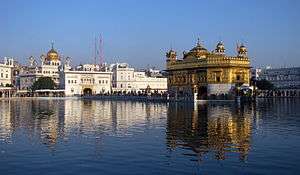 Golden Temple and the Akal Takht, Amritsar
Golden Temple and the Akal Takht, Amritsar.jpg) Badshahi Mosque, Lahore
Badshahi Mosque, Lahore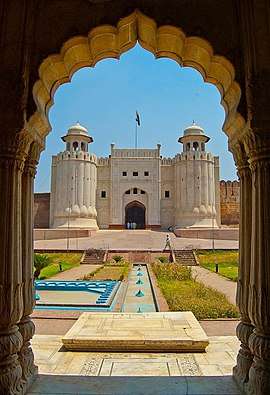 Lahore Fort, Lahore
Lahore Fort, Lahore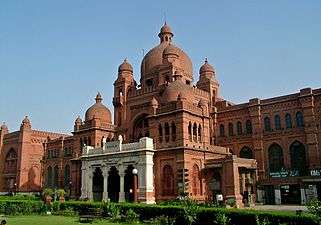 Lahore Museum, Lahore
Lahore Museum, Lahore Shalimar Gardens
Shalimar Gardens- Jahangir's Tomb, Lahore
See also
Notes
- ↑ The left/right bank of a river is determined by looking in the direction of flow of the river (facing downstream).
References
- ↑ Discover India http://www.discoveredindia.com/punjab/about-punjab/regions-in-punjab.htm
- 1 2 3 Grover, Parminder Singh (2011). Discover Punjab: Attractions of Punjab. Parminder Singh Grover. p. 179.
- ↑ Advanced Centre for Technical Development of Punjabi Language, Literature and Culture, Punjabi University, Patiala Punjabi University, Patiala.
- ↑ Punjab Data, Know Everything About Punjab http://www.punjabdata.com/Majha-Malwa-Doaba.aspx
- ↑ Mahmood, Cynthia Keppley (1996). Fighting for Faith and Nation: Dialogues with Sikh Militants (Contemporary Ethnography), p. 153. Philadelphia, University of Pennsylvania.
- ↑ Sandhu, Gulzar Singh (2004). Gods on Trial and Other Stories, p. 132. Diamond Pocket Books. ISBN 8128808087
- ↑ Vipul Punjabi https://vipulpunjabi.wordpress.com/regions-and-districts/majha/
- ↑ Kakshi, S.R.; Pathak, Rashmi; Pathak, S.R.Bakshi R. (2007-01-01). Punjab Through the Ages. Sarup & Sons. ISBN 978-81-7625-738-1. Retrieved 12 June 2010.
- ↑ Rawalpindi: Majha, Punjab, Islamabad, Tribes and Castes of Rawalpindi District, Rawalpindi District, Demography of Rawalpindi District https://www.amazon.it/Rawalpindi-Punjab-Islamabad-District-Demography/dp/6131076170
- ↑ Singh, Raj Pal (1998). Banda Bahadur and His Times p. 22. Harman Pub. House, 1 Aug 1998.
- ↑ http://centralsikhmuseum.com/today-in-sikh-history-5th-september/
